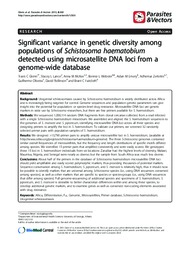Significant variance in genetic diversity among populations of Schistosoma haematobium detected using microsatellite DNA loci from a genome-wide database.
Significant variance in genetic diversity among populations of Schistosoma haematobium detected using microsatellite DNA loci from a genome-wide database.
Author(s): GLENN, T. C.; LANCE, S. L.; MCKEE, A. M.; WEBSTER, B. L.; EMERY, A. M.; ZERLOTINI, A.; OLIVEIRA, G.; ROLLINSON, D.; FAIRCLOTH, B. C.
Summary: Background: Urogenital schistosomiasis caused by Schistosoma haematobium is widely distributed across Africa and is increasingly being targeted for control. Genome sequences and population genetic parameters can give nsight into the potential for population- or species-level drug resistance. Microsatellite DNA loci are genetic markers in wide use by Schistosoma researchers, but there are few primers available for S. haematobium. Methods: We sequenced 1,058,114 random DNA fragments from clonal cercariae collected from a snail infected with a single Schistosoma haematobium miracidium. We assembled and aligned the S. haematobium sequences to the genomes of S. mansoni and S. japonicum, identifying microsatellite DNA loci across all three species and designing primers to amplify the loci in S. haematobium. To validate our primers, we screened 32 randomly selected primer pairs with population samples of S. haematobium. Results: We designed >13,790 primer pairs to amplify unique microsatellite loci in S. haematobium, (available at http://www.cebio.org/projetos/schistosoma-haematobium-genome). The three Schistosoma genomes contained similar overall frequencies of microsatellites, but the frequency and length distributions of specific motifs differed among species. We identified 15 primer pairs that amplified consistently and were easily scored. We genotyped these 15 loci in S. haematobium individuals from six locations: Zanzibar had the highest levels of diversity; Malawi, Mauritius, Nigeria, and Senegal were nearly as diverse; but the sample from South Africa was much less diverse. Conclusions: About half of the primers in the database of Schistosoma haematobium microsatellite DNA loci should yield amplifiable and easily scored polymorphic markers, thus providing thousands of potential markers. Sequence conservation among S. haematobium, S. japonicum, and S. mansoni is relatively high, thus it should now be possible to identify markers that are universal among Schistosoma species (i.e., using DNA sequences conserved among species), as well as other markers that are specific to species or species-groups (i.e., using DNA sequences that differ among species). Full genome-sequencing of additional species and specimens of S. haematobium, S. aponicum, and S. mansoni is desirable to better characterize differences within and among these species, to develop additional genetic markers, and to examine genes as well as conserved non-coding elements associated with drug resistance.
Publication year: 2013
Types of publication: Journal article
Observation
Some of Embrapa's publications are published as ePub files. To read them, use or download one of the following free software options to your computer or mobile device. Android: Google Play Books; IOS: iBooks; Windows and Linux: Calibre.
Access other publications
Access the Agricultural Research Database (BDPA) to consult Embrapa's full library collection and records.
Visit Embrapa Bookstore to purchase books and other publications sold by Embrapa.

